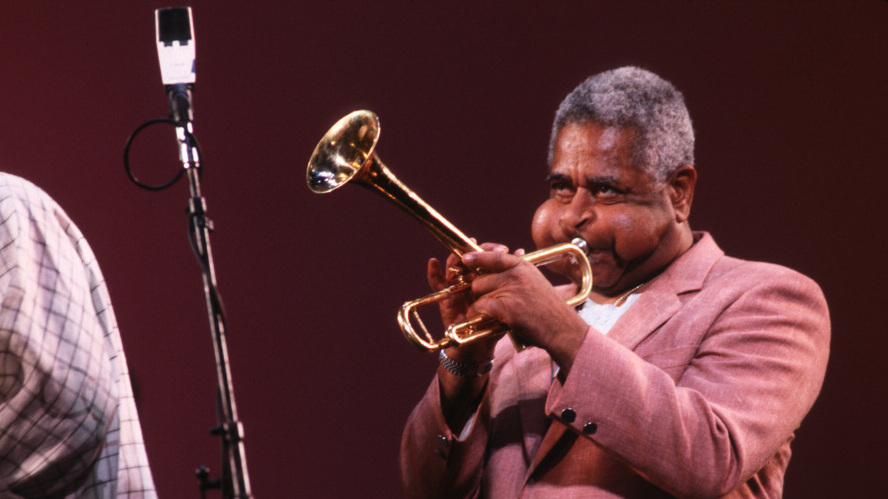Dizzy Gillespie: The Trumpet Virtuoso Who Revolutionized Jazz
Introduction
John Birks “Dizzy” Gillespie is widely celebrated not only as one of the most influential jazz trumpeters of all time but also as a pioneer who helped shape the very sound of modern jazz. Though primarily associated with bebop and Afro-Cuban jazz, Gillespie’s musical roots and stylistic influence also touch the world of blues, where his improvisational creativity and expressive range brought new dimensions to the genre.

Early Life and Musical Roots
Dizzy Gillespie was born on October 21, 1917, in Cheraw, South Carolina. The youngest of nine children, he grew up in a home filled with music. His father, a local bandleader, introduced him to instruments early on, and by age 12, Gillespie was teaching himself to play the trumpet and trombone.
While Dizzy’s early environment was deeply connected to Southern musical traditions—including the blues—his technical curiosity and unquenchable thirst for innovation would lead him to explore beyond the limits of traditional forms. Blues rhythms, however, remained a constant foundation in his phrasing, tonal expression, and improvisation throughout his career.
The Birth of Bebop
In the 1940s, Gillespie moved to New York City, where he became immersed in the cutting-edge jazz scene at clubs like Minton’s Playhouse and Monroe’s Uptown House. Alongside other greats such as Charlie Parker, Thelonious Monk, and Kenny Clarke, Gillespie co-created bebop, a revolutionary style characterized by complex harmonies, lightning-fast tempos, and bold improvisations.
While bebop took jazz into uncharted territory, it didn’t abandon the blues. Gillespie’s solos often incorporated blue notes, call-and-response motifs, and emotionally expressive inflections, blending technical brilliance with bluesy soulfulness.
Blending Cultures: Afro-Cuban Jazz
Another pivotal moment in Gillespie’s career was his collaboration with Cuban percussionist Chano Pozo in the late 1940s. Together, they created a fusion of jazz and Afro-Cuban music that gave birth to Latin jazz. Works like “Manteca” and “Cubana Be, Cubana Bop” combined blues-based trumpet lines with infectious Afro-Cuban rhythms, broadening jazz’s global appeal.
This innovation highlighted Gillespie’s belief in music as a universal language—one that could bridge continents and traditions. The deep rhythmic patterns of Afro-Cuban music resonated with the roots of blues, making their fusion a natural and powerful expression.
The Iconic Look and Sound
Dizzy Gillespie was not only known for his virtuosic trumpet playing but also for his visually distinctive bent trumpet and his puffed cheeks—both of which became his trademarks. His trumpet’s bell famously bent upward at a 45-degree angle, a modification that came from an accidental damage but was later preserved for its unique sound projection.
His style was explosive yet controlled, playful yet profound. His solos moved effortlessly between lightning-speed runs and melodic blues phrases, demonstrating both his technical mastery and emotional depth.
Mentor and Educator
Throughout his life, Gillespie was a generous mentor to young musicians. He nurtured the talents of future legends like Miles Davis, John Coltrane, and Art Blakey, encouraging them to embrace innovation while remaining rooted in tradition. His educational legacy includes countless clinics, workshops, and performances that inspired new generations of jazz and blues artists.
Cultural Ambassador and Awards
Dizzy Gillespie was also a cultural ambassador for the United States, using his tours abroad in the 1950s and beyond to promote jazz as a symbol of freedom and creativity. His international travels introduced new audiences to jazz, especially in countries with rich musical traditions that shared rhythmic and emotional similarities with blues.
Over the course of his career, Gillespie received numerous accolades, including:
- Grammy Lifetime Achievement Award (1989)
- Kennedy Center Honors (1990)
- National Medal of Arts (1989)
Legacy and Influence
Dizzy Gillespie passed away on January 6, 1993, but his legacy lives on in the notes of every trumpeter who dares to innovate, in every jazz piece that flirts with the blues, and in the enduring power of music to unite people across boundaries.
He remains a symbol of creative genius—one who respected the past, transformed the present, and envisioned the future of music. Though primarily a jazz figure, his deep ties to the blues and his ability to infuse it with new energy have left an indelible mark on the genre.
Conclusion
Dizzy Gillespie’s biography is more than a chronicle of a brilliant trumpeter—it is the story of a visionary who elevated jazz and blues to new artistic heights. His music was complex, joyful, daring, and above all, deeply human. Whether blowing his iconic bent trumpet or mentoring a young musician, Gillespie brought the soul of blues into every note.

Comments are closed